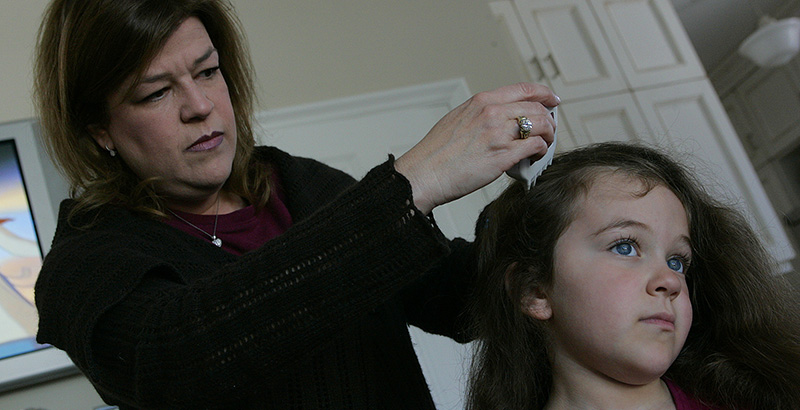Surviving ‘Super Lice’ — 6 Things Parents Should Know About the Latest Classroom Outbreak

You’ve never been so tempted to temporarily divorce your family.
And if you felt outgunned — and definitely outnumbered — by the little creatures before, now you have the added hysteria of a new, mutant bug known as “super lice,” sweeping the media. Reports cite an “outbreak” in over 25 states of lice so strong they are resistant to almost all chemical treatments:
Is the hype warranted and what should you be doing in your lonely war on lice? While Pediculus humanus capitis, aka head lice, are unwelcome guests, they are also victim of bad PR. For example, despite commonly held assumptions, head lice do not spread diseases, cannot be spread by dogs or other pets, and lack the ability to hop, jump, or fly.
But lice can and do come calling with regularity — the Centers for Disease Control estimates that between 6 and 12 million infestations of head lice occur per year in kids between the ages of 3 and 11 — so being prepared to deal with an infestation can make parents’ and schools’ lives much easier.
The 74 spoke to two seasoned veterans on the front lines of the lice and super lice battle to clear up some other lousy rumors going around about head lice, and share insights for parents to keep in mind.
For Abigail Rosenfeld, who more than 20 years ago became the go-to “Lice Lady” of New York City, super lice is nothing to panic over, likening their “super power” resistance to chemical treatments to when humans become dependent on antibiotics and they become less effective
She is also old-school in her approach to lice and super lice, eschewing chemicals for diligent combing. “Lice is a bug, not a disease,” she reminds panicked parents. And when it comes to other common but non-chemical treatments such as smothering a child’s head in Cetaphil lotion, blow drying it and covering the entire thing overnight in a shower cap (one of The 74’s editors swears by this as a backup technique after you’ve combed for hours), Rosenfeld pooh-poohs these remedies.
“If you can just remove them [through combing], why would you sit through all that?” she asks.
Her name is passed around the private and public school circuit in New York City, and over the years she’s seen it all — including one freaked-out parent who sprayed Raid on her kids who had lice and was shocked when it didn’t work. Rosenfeld charges a flat-fee for painstakingly picking through lice-infested heads: Between $100 and $200 per head, depending on thickness of hair and aggressiveness of infestation. The fee comes with a fine-tooth comb to take home and a free follow-up.
Donna Taylor is the principal of the K-8 Brooklyn School of Inquiry, and is also a proponent of diligent combing and patience, which she preaches while constantly dealing with lice outbreaks and panicked parents.
“All schools have lice outbreaks all the time, it’s one of those pesky problems,” she said. “Every time we’ve done a head check, we find lice.”
So what happens when you do find lice creeping and crawling around your child’s head? First, breathe and try not to scream, and then keep these tips and tricks in mind:
Resist the urge to purge your home of all fabrics with which lice may have come into contact. Rosenfeld recalls one mother who came to see her, hysterical to the point she’d ripped out her carpets and yet her children still had lice.
That is because lice can only live on hair. To repeat: Lice can only live on hair. The most common way to transfer lice is by direct contact. Yes, lice can be transferred through fabric, hats, and other similar means, but they cannot live for long outside the human head.
Sheets, blankets, and clothes should simply be washed and dried on high temperatures to rid the fabrics of lice, while things that can’t easily be washed, like pillows and rugs, should be put in plastic bags and sealed for two weeks, says Rosenfeld.
Rosenfeld swears by the old-school technique of a fine-toothed German made comb and plenty of Pantene conditioner — no chemical shampoos or other remedies needed. Every client that comes to see her leaves with their own personal comb for home-care.
The best way to make sure all lice and nits are gone, Rosenfeld says, is to use a combination of her German-made hair comb, Pantene, which sticks to the hair and pulls out the nits and lice when combed through, and plenty of patience
Taylor stresses the same advice to hysterical parents at her school. “You really have to be quite neurotic in order to get [all the nits and lice]. There is no way around it, you have to comb every night with a comb and Pantene.”
A common misconception about lice is that they are related to dirt. This is entirely untrue, and a lice outbreak has nothing to do with the cleanliness of a home or person or school.
“There is no socioeconomic status for lice,” Taylor said ”They just love a good head.”
“Lice has a bad reputation, so people go crazy [when they get it],” agreed Rosenfeld. In reality, she continued, “You can pick up lice in five-star hotels and Saks Fifth Avenue. It has nothing to do with dirt at all.”
The same goes with schools and students, Taylor said. “The last thing I want to do is argue with a parent about whether or not their kid has lice,“ she said. “It doesn’t matter if your kid showers everyday.”
And what about parents who are appalled that a student with lice is sent back to the classroom? The rule now in New York City is a child can only be sent home if there are live lice (meaning students with nits are promptly sent back to class), and many districts are going a step further, opting for students to be allowed to return to class even with live lice in their hair.
Horrified? Don’t be. Here’s something else to keep in mind: The Centers for Disease Control, the American Academy of Pediatrics, and the National Association of School Nurses recommend that students diagnosed with head lice need not be sent home, and that “‘no-nit’ policies be discontinued.”
Itch, and learn.
Get stories like these delivered straight to your inbox. Sign up for The 74 Newsletter

;)
